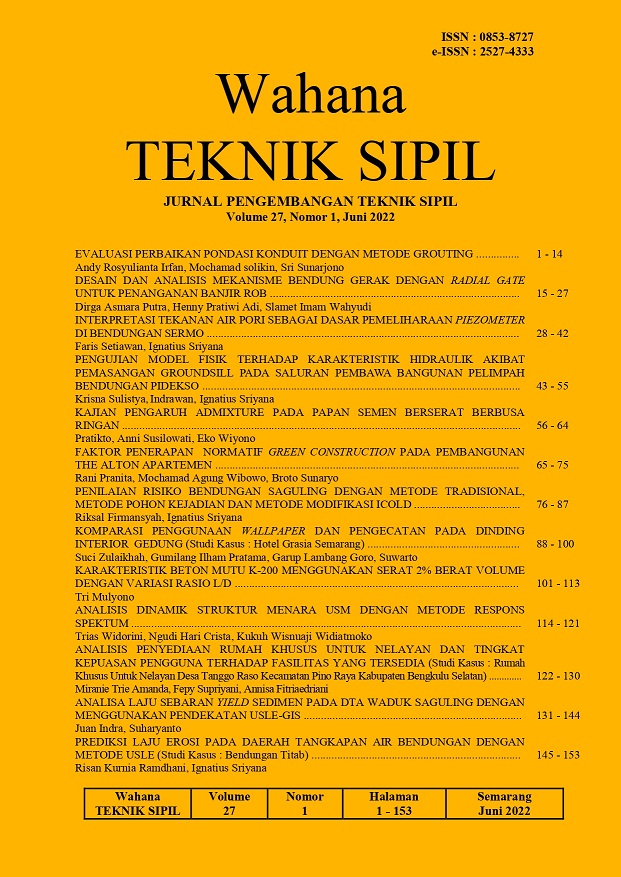KAJIAN RANCANG BANGUN ALAT UKUR DEBIT AMBANG LEBAR DENGAN VARIASI KEMIRINGAN HILIR
DOI:
https://doi.org/10.32497/wahanats.v27i1.3749Keywords:
overflow, broad crested weirs, energy loss.Abstract
The modeling of broad crested weirs is expected to facilitate understanding, especially the behavior of the flow flowing through the measuring instrument. The flow behavior under consideration is hydraulic behavior, measurement accuracy, and discharge curve. In addition, there is a relationship between discharge and water level upstream and downstream of the spillway, as well as the relationship of the variation of discharge flowing through the broad crested weirs to the loss of energy height. From the results of this study, it was found that there was a relationship between discharge and water level upstream, downstream, water level above the threshold, and energy loss for wide-threshold spillway. The modeling of the broad crested weirs assumes that the Froude number that occurs in the model is the same as the Froude number that occurs in the field. So that the scale of discharge, time, velocity and volume will be able to represent the actual conditions in the field. The scale of length, width, and height of the prototype is 1: 100. The methodology used is to carry out testing in the hydraulics laboratory by varying Q1, Q2, Q3, Q4, ”¦. Qn, to obtain variations in water level upstream and downstream of the broad crested weirs. From the results of the study, it was found that the energy loss was relatively small with a trend of Y = 101.66x2 - 0.7359x + 0.0017 with the slope of the broad crested weirs downstream is 1:2, Y = 467.84x2 - 1.7816x + 0.0022 for slope of the broad crested weirs downstream is 1:1.5, and Y = -1140,4x2 + 0.6383x + 0.0077 with the slope of the broad crested weirs downstream is 1:1 where Y is the energy loss in meters and X is the discharge in m3/sec.References
Alboresha, R. dan Hatem, U., 2021, Effect of Height and Surface Roughness of a Broad Crested Weir on the Discharge Coefficient: Experimental Study, IOP Conf. Series: Materials Science and Engineering 1090-012087
Al-Hashimi, S. A. M., Madhloom, H. M., Khalaf, R. M., Nahi, T. N., dan Al-Ansari, N. A., 2017, Flow over Broad Crested Weirs: Comparison of 2D and 3D Models, Journal of Civil Engineering and Architechture 11, 769-779
Pusat Pendidikan dan Pelatihan Sumber Daya Air dan Konstruksi, 2016, Diklat Teknis Perencanaan Irigasi, Kementerian Pekerjaan Umum dan Perumahan Rakyat, Bandung
Saleh, S. S., Musa R., dan As”™ad H., 2019, Kajian Karakteristik Aliran Terhadap Bangunan Pelimpah Pada Saluran Terbuka. Jurnal Teknik Hidro. Vol. 12 Nomor 2
Suhardi, 2020, Rancang Bangun Prototipe Saluran Irigasi Skala Laboratorium, Jurnal Ilmiah Rekayasa Pertanian dan Biosistem. Vol. 8, Nomor 1
Yildiz A., Yarbasi G.E. Yarar A. dan Marti A., 2020, Modelling of board crested weirs by using dynamic similarity and CFD, Romanian Journal of Ecology & Environmental Chemistry. Vo. 2, No. 2.
Downloads
Published
Issue
Section
License
Authors who publish with this journal agree to the following terms:Authors retain copyright and grant the journal right of first publication with the work simultaneously licensed under a Creative Commons Attribution License that allows others to share the work with an acknowledgement of the work's authorship and initial publication in this journal.
Authors are able to enter into separate, additional contractual arrangements for the non-exclusive distribution of the journal's published version of the work (e.g., post it to an institutional repository or publish it in a book), with an acknowledgement of its initial publication in this journal.
Authors are permitted and encouraged to post their work online (e.g., in institutional repositories or on their website) prior to and during the submission process, as it can lead to productive exchanges, as well as earlier and greater citation of published work (See The Effect of Open Access).






